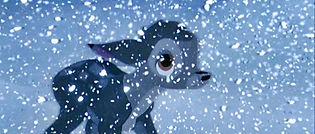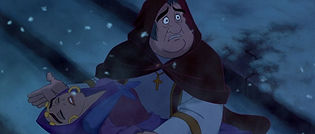Parental Influence in Disney Animated Movies
THE LION KING
BAMBI
LILO & STITCH
FROZEN
CINDERELLA
HUNCHBACK OF NOTRE DAME
Portrayals of Death
The importance of parental death can be revealed if one looks into Joseph Campbell's The Hero With A Thousand Faces. Several decades ago, Christopher Vogler developed a memo outlining the basic concepts of the hero's journey, or the monomyth, as detailed by Joseph Campbell and inspired Disney executives to establish it as required reading among their staff. (Vogler) The archetypal story structure has been built into several Disney films since this time.
The first step of the hero's journey is “the ordinary world” where the audience learns the usual routine of the main character including their personality traits, personal issues, and background. In some Disney films, the protagonist’s ordinary world includes a deceased parent. In films such as Pocahontas, growing up without a parent frequently causes the protagonist to be more responsible than the typical person in their cohort. In this case, the audience accepts this aspect of the character’s personality as it is defined and sometimes sympathizes with the inherent struggle that occurs from this situation. At times, character interactions and dialogue that reference this loss may lead to a reaction in the hero that demonstrates to the audience the unmistakable impact the death had on their life. When Pocahontas and her father speak of her mother, there is a pained look on her face, and she often aspires aloud to be just like her. Often, the character seeks to become like or accepted by their deceased parent. In Lilo & Stitch, Nani struggles to be like her own mother to Lilo and provide guidance, discipline, and resources for her sister.
The next step and the true catalyst of the monomyth is “the call to adventure” where the hero must accept changes into their lives either due to external pressure or internal conflict. Several Disney films have used a parent’s death to send the character on a journey. In the Lion King, Mufasa dies in front of Simba, forcing him to cope with the reality of death and destruction as well as robbing him of his mentor and protector. Because of his uncle’s cruel manipulations, Simba chooses to run away with his survivor’s guilt from the truth and his responsibility for the kingdom. When the king and queen die in Frozen, Elsa, the eldest daughter, accepts that she must now face her unwieldly powers alone and eventually ascend to the throne without the protection of her family. She decides to isolate herself completely from others to deal with her issues as a method of embracing responsibility for herself.
When considering parents dying on screen, there are two instances where the audience actually sees a parent die. When Frollo causes Quasimodo’s mother to fall backwards and crack her skull against the stairs of Notre Dame, the audience is horrified to see this act of pure evil and shocked to witness such a dark scene at the sheer evil of him and shocked to see such a dark scene in The Hunchback of Notre Dame. For the remainder of the film, this violence influences the viewer’s perspective of the treatment of the gypsies and the establishment of Frollo as the true villain.
In the most impactful example, the audience watches as Simba, helpless and in shock, burns the memory of his father’s impending doom as he dramatically, in slow motion, falls into the chaotic wildebeest stampede. Viewers feel completely hopeless upon seeing the ultimate father image and Christ-figure sacrificing his life for his son, and Simba becomes an understandable tragic figure as the audience copes with the idea of losing their own father.
For most Disney films, when the parent dies, the death occurs offscreen which, while tragic, is not as traumatic as actually seeing the graphic details. In Bambi, the scene slowly builds up dramatically with music and anxiety in the mother doe’s expression and body language. The audience hears one gunshot and sees the mother dodge it, but when the film cuts to Bambi’s running and there are two shots, the viewer just knows that the mother is dead. Seeing the hysteria as Bambi realizes his mother is not behind him, it evokes the thought of losing a parent and pity for the little deer.
In the very opening scenes of Cinderella, there is a still image of the little girl with her face buried in her father’s bed as she is overcome with grief and hopelessness. The audience understands her desperation and sorrow and knows that she will suffer for the remainder of the film as she tends to her cruel stepmother.





